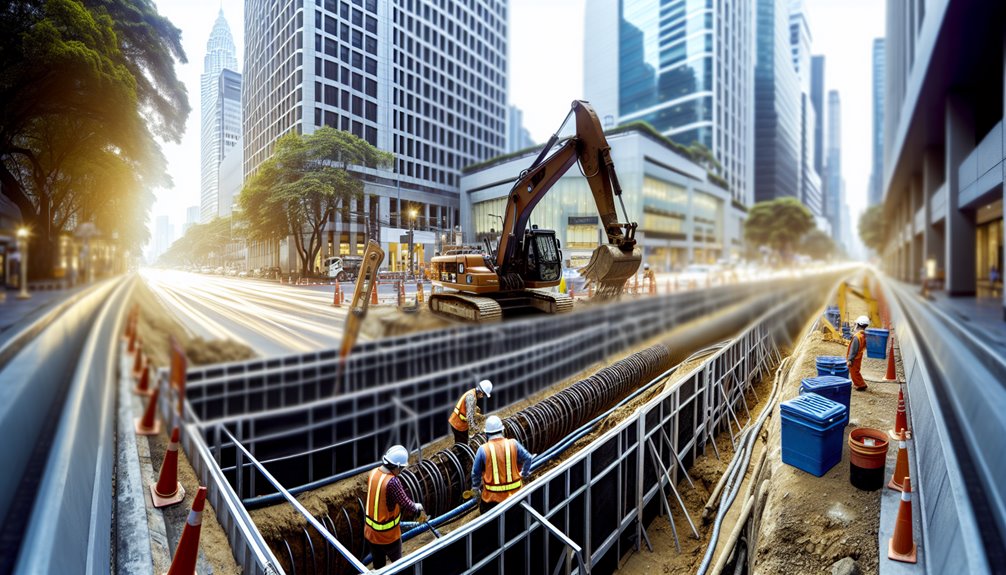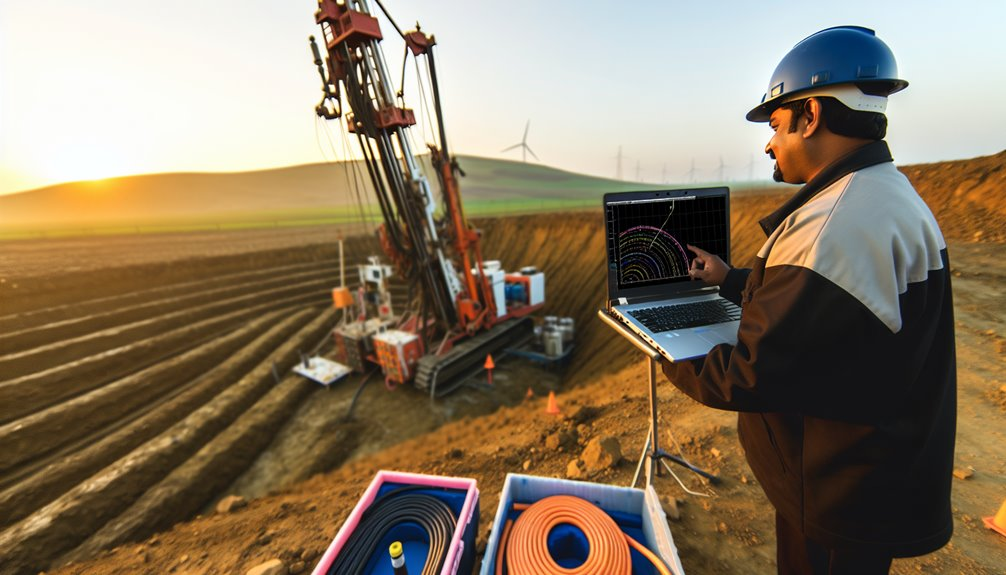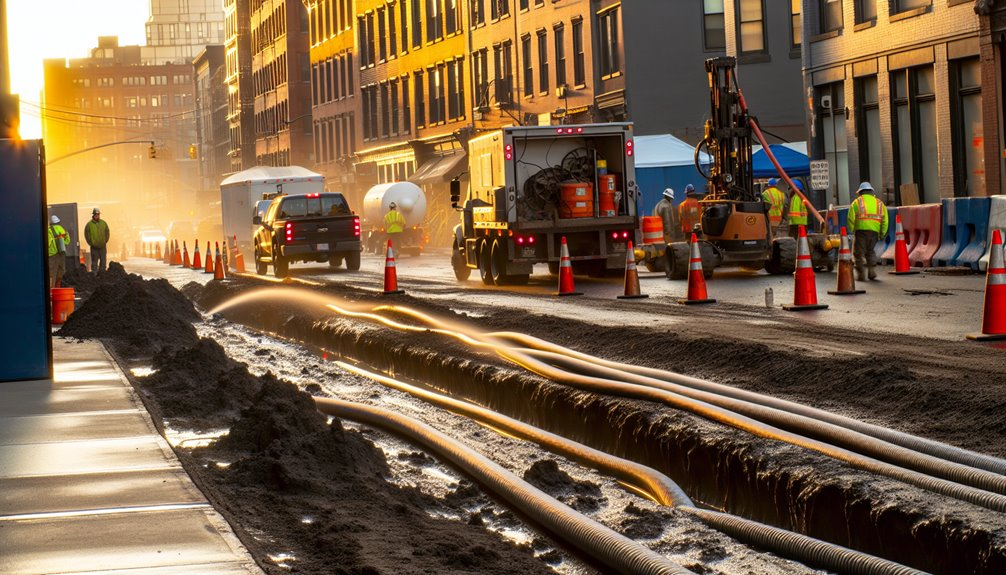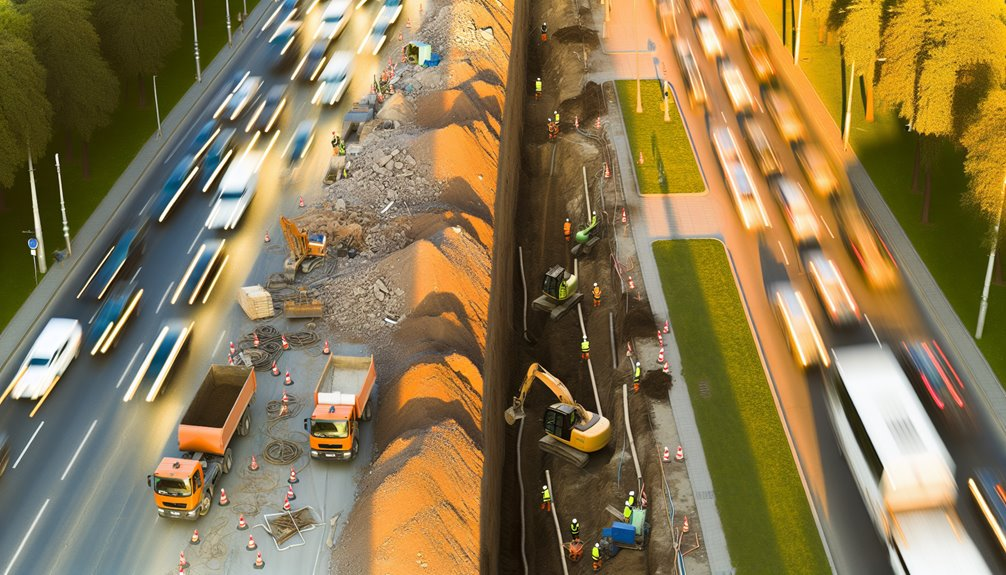When you're tackling trenching projects in urban settings, you must navigate a maze of existing utilities and tight spaces. You'll rely heavily on trenchless technologies to minimize surface disruption and maintain traffic flow. This approach, while efficient, demands precise planning and risk assessment to avoid damaging underground structures. As you'll see, the complexity of these environments tests even the most seasoned professionals, making it essential to stay updated on the latest methodologies and safety standards. Let's explore how these challenges are met head-on.
Urban Trenching: Overcoming Infrastructure and Space Limitations
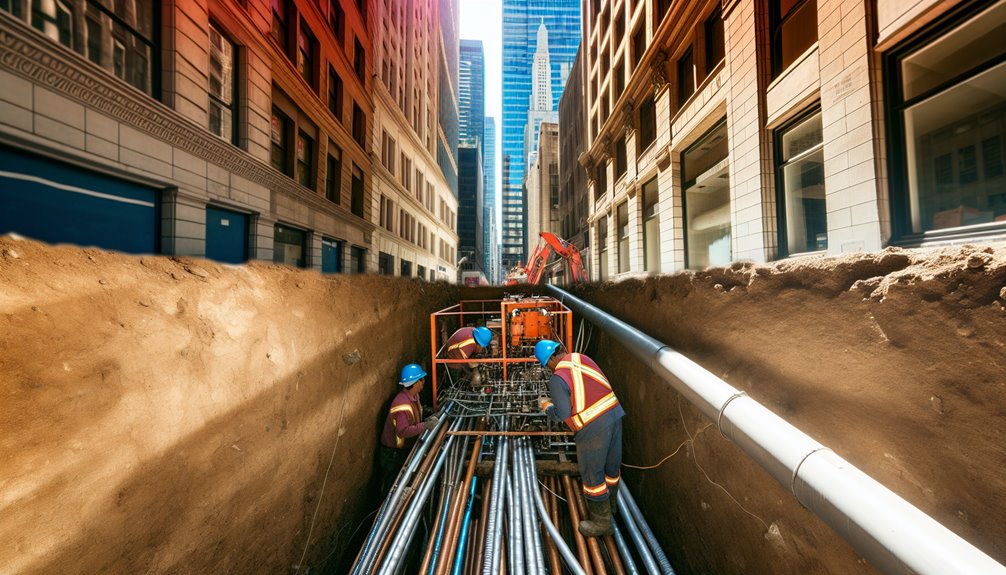
While urban trenching presents unique challenges due to infrastructure density and limited space, adopting the right methods can considerably mitigate these issues.
You should consider trenchless techniques, which minimize disturbances by requiring only small entry and exit points. This method is particularly suitable near sensitive urban infrastructure, where traditional excavation could risk damage to underground utilities.
Additionally, employing smaller, precision-based equipment like chain trenchers allows for operation in confined spaces, ensuring that trench depth and width adhere to urban constraints without compromising structural integrity.
Efficient spoil management is also essential; continuous windrow placement or temporary disposal sites help manage debris in limited spaces.
Chain trenchers, when employed correctly, balance efficiency and the need for precision in confined urban spaces, making them ideal for urban trenching situations.
Prioritize these innovative trenching techniques to enhance safety and reduce environmental impact in urban settings.
Coastal Area Challenges: Managing Trenching in High Erosion Zones
As you tackle trenching in coastal areas, understanding erosion impact mitigation techniques is essential for maintaining soil stability and ensuring safety. You'll need to choose between various stabilization solutions like geotextiles or Triton Marine Mattresses, which must be carefully planned to suit the dynamic coastal subgrades. It's imperative to employ proven design strategies and robust engineering to keep these high erosion zones secure during and after the trenching process. Tensar's geosynthetic solutions, including Triton Marine Mattresses, offer adaptability and durability, enhancing erosion control and stability in these challenging environments.
Erosion Impact Mitigation Techniques
To effectively manage trenching in coastal areas prone to high erosion, it's crucial to implement targeted erosion impact mitigation techniques.
You'll need to incorporate both hard and soft stabilization methods to control erosion and manage sediment effectively. Utilizing geotextiles can provide critical reinforcement for soil structures, enhancing both seawall and breakwater resilience against aggressive wave action.
Simultaneously, adopting soft stabilization approaches like beach nourishment and vegetation planting not only broadens the shoreline but also fortifies it naturally, reducing the energy of incoming waves.
Each technique must be precisely tailored to the specific environmental conditions of your project site, ensuring that your trenching operations are safeguarded against the dynamic and often harsh coastal processes.
Coastal Soil Stability Solutions
Given the high erosion susceptibility of coastal areas, adopting robust coastal soil stability solutions is essential for effective trenching management.
Beach nourishment involves replenishing sand to absorb wave energy and mitigate erosion, but it requires ongoing monitoring and potentially periodic re-nourishment.
Similarly, integrating living shorelines introduces vegetation and natural structures to stabilize and enrich the coastal environment. These methods not only prevent erosion but also enhance habitat quality, making them doubly beneficial.
Furthermore, innovative techniques like fiberglass soil nails offer a durable, non-corrosive method to reinforce soil mechanically, vital for maintaining trench integrity in volatile zones.
Combining these solutions provides an all-encompassing approach that addresses both immediate and long-term stability challenges in coastal trenching operations.
Trenching in Arid Regions: Addressing Water Scarcity and Soil Instability
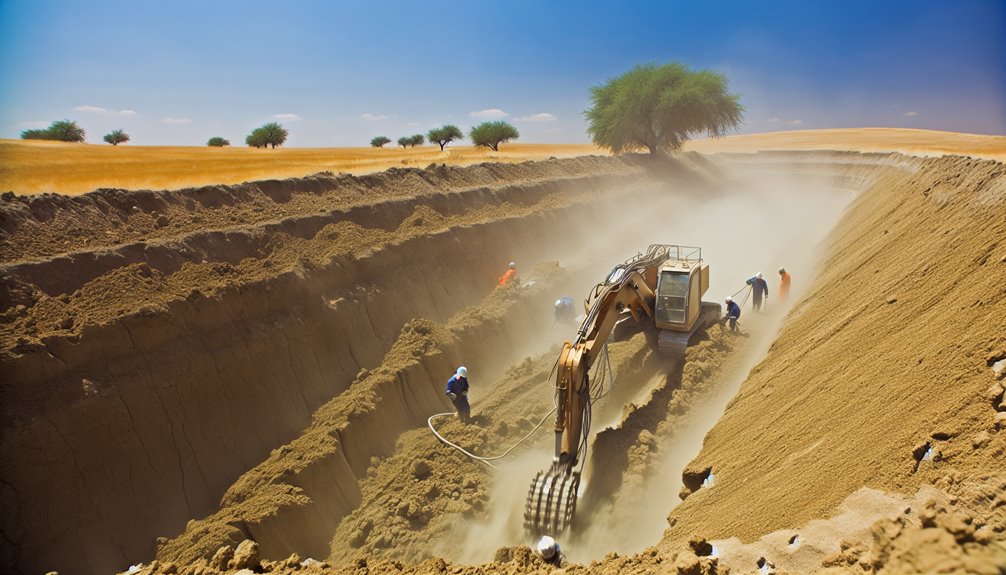
To address the dual challenges of water scarcity and soil instability in arid regions, you must consider both soil stabilization techniques and water conservation strategies.
Using geotextile fabrics can prevent erosion while maintaining soil structure, essential for the stability of your trenching projects.
Additionally, designing your trenches for efficient water capture and retention will mitigate the effects of limited rainfall and high evaporation rates, ensuring long-term sustainability and safety in these harsh environments.
Soil Stabilization Techniques
In arid regions, addressing water scarcity and soil instability is crucial, especially during trenching operations.
You'll find soil compaction techniques indispensable. Using rollers and plate compactors optimizes soil density, effectively handling the region's challenging conditions.
Additionally, explore chemical stabilization methods. Mixing Portland cement or hydrated lime into the soil greatly enhances its strength and durability, ideal for supporting heavy loads.
For a tailored approach, consider soil stabilization polymers that bind soil particles, reducing erosion and improving cohesion.
These innovative methods not only guarantee safety but also enhance the efficiency of your trenching projects by stabilizing the soil in environmentally sensitive and resource-scarce settings.
Water Conservation Strategies
While addressing water scarcity and soil instability in arid regions, it's vital to implement effective water conservation strategies during trenching operations.
You can enhance soil moisture and promote rainwater harvesting by designing trenches along contour lines, which helps retain rainwater and reduce runoff. This technique not only prevents water loss but also bolsters subsoil water reserves, essential for crop survival during dry spells.
Additionally, contour trenching mitigates soil erosion by stabilizing the terrain and retaining fertile soil particles, important in maintaining land productivity.
Implementing such innovative strategies guarantees that water is conserved efficiently while maintaining soil health, ultimately extending the growing season and improving crop yields in challenging arid landscapes.
Alpine and Mountainous Terrain: Strategies for Trenching in Steep and Rocky Conditions
Steering through the challenges of trenching in alpine and mountainous terrain requires a meticulous approach, especially given the steep and rocky conditions you'll face.
When undertaking alpine trenching, ascertain trenches are oriented at a 90-degree angle to the slope to enhance stability and anchor strength. The trench must be sufficiently flat and broad to secure your axe firmly, vital in steep terrain where safety can't be compromised.
Utilize a pick for creating a precise central channel and always test the anchor's reliability before full commitment. Employ a clove hitch for securing the axe, optimizing both safety and efficiency.
Trenching Near Protected Habitats: Balancing Development and Environmental Preservation
Trenching near protected habitats demands a finely balanced approach that prioritizes both development needs and environmental preservation.
You must conduct a thorough habitat assessment before any ground is broken. Adjusting construction timing to avoid disrupting breeding seasons or migration patterns is essential.
Here are key steps to visualize:
- Pre-Construction Habitat Assessment: Detailed studies of local flora, fauna, and water dynamics shape project plans.
- Erosion Control Implementation: Techniques like shallow contour trenches prevent water run-off, protecting soil and water quality.
- Community-Engaged Restoration: Engage local communities in restoration, ensuring minimal disruption and promoting ecological benefits.
Utilizing Advanced Technologies for Efficient Trenching in Frozen Terrains
To tackle the challenges of trenching in frozen terrains, operators must deploy advanced technologies that enhance efficiency and secure safety.
Chain trenchers, equipped with sharp, robust teeth, are essential for cutting through the frost layer and compacted soils, allowing for deep and wide trenching. These machines offer features like automatic depth control and adjustable digging angles, optimizing frozen excavation tasks.
Preconstruction planning is vital; techniques such as using snow as an insulating barrier and segregating topsoil can prevent soil mixing and secure stable trench walls.
For areas with unconsolidated subsoils, employing rotary wheel trenchers with rock buckets helps maintain topsoil integrity, vital for environmental restoration post-trenching.
This approach, focusing on precision and safety, harnesses trenching technology effectively in challenging frozen conditions.
Conclusion
In summary, you must tailor your trenching strategies to the specific challenges of each environment. Urban areas demand trenchless technologies to limit disruptions, while coastal zones require erosion controls like geotextiles. In arid regions, addressing water scarcity and soil stability is essential. When working in mountainous or frozen terrains, leverage advanced technologies and maintain stringent safety protocols. Always balance development with environmental preservation, especially near protected habitats, to guarantee a sustainable and safe trenching operation.
If you're interested in learning more about effective trenching solutions or have specific questions, I invite you to visit Boring Bros at boringbro.com or give us a call at (954) 639-6167. We're here to help you navigate your trenching needs with expertise and care!

